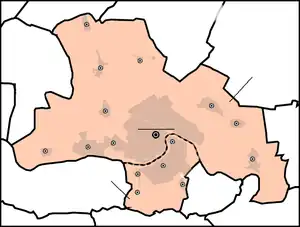Futog
Futak | |
|---|---|
.png.webp) Coat of arms | |
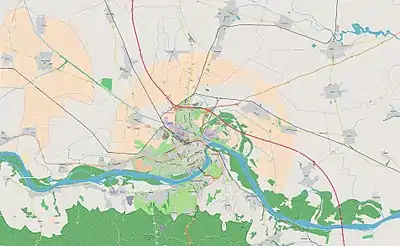 Futog Location within Novi Sad 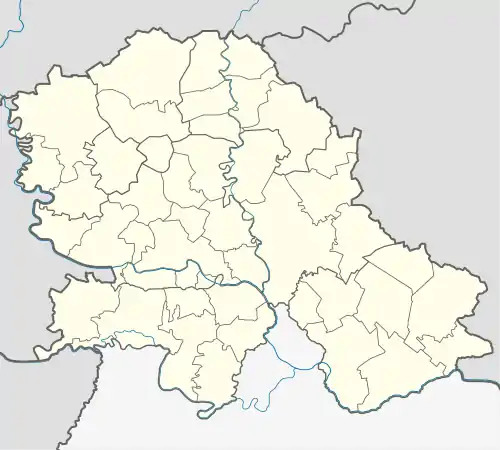 Futog Futog (Vojvodina) 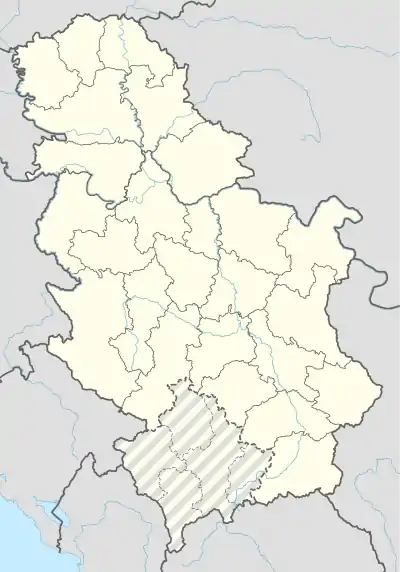 Futog Futog (Serbia) | |
| Coordinates: 45°14′N 19°43′E / 45.233°N 19.717°E | |
| Country | |
| Province | |
| District | South Bačka |
| Municipality | |
| Area | |
| • Total | 83.27 km2 (32.15 sq mi) |
| Population (2011) | |
| • Total | 18,641 |
| • Density | 220/km2 (580/sq mi) |
| Time zone | UTC+1 (CET) |
| • Summer (DST) | UTC+2 (CEST) |
| Postal code | 21410 |
| Area code | +381(0)21 |
| Car plates | NS |
Futog (Serbian Cyrillic: Футог, German and Hungarian: Futak) is a suburban settlement of the city of Novi Sad, Serbia, with a population of 18,642 according to the 2011 census in Serbia. It is situated in southern Bačka, 7 km away from Novi Sad.
Name
Terra que Futog et a quibusdam Batkay nominatur is the first written mention of this village in 1250. It was formed from a personal name (+1086: Futoc) with a Hungarian nomenclature. The basis of the name is the hungarian derivative the verb fut, which means running, with a meaning of “courier”.[2]
In Serbian, the town is known as Futog (Футог), in Croatian as Futog, in Hungarian as Futak, and in German as Alt-Futok.
Demographics
| Year | Pop. | ±% |
|---|---|---|
| 1948 | 5,366 | — |
| 1953 | 6,049 | +12.7% |
| 1961 | 8,256 | +36.5% |
| 1971 | 10,614 | +28.6% |
| 1981 | 14,664 | +38.2% |
| 1991 | 16,048 | +9.4% |
| 2002 | 18,582 | +15.8% |
| 2011 | 18,641 | +0.3% |
| Source: Census [3] | ||
The town had a population of 18,582 (2002 census). Ethnic groups included:
- Serbs = 16,828 (90.56%)
- Hungarians = 279 (1.50%)
- Yugoslavs = 226 (1.22%)
- others = 1249 (6.72%)
The population of the settlement was a quarter under 15 years old, two-thirds work-capable people, and 10% farmers.
Geography
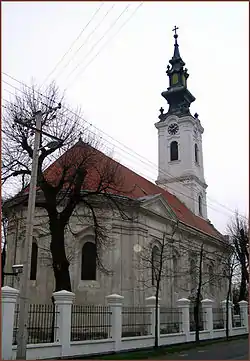
The town is situated in southern Bačka, 7 km away from Novi Sad, on the middle of the Danube stream. Neighbouring settlements are Veternik in the east, Begeč in the west and Rumenka in the north. The Danube river is located in the south of the town. The Futog area outspreads on a cofin terrace, alluvial plain and an inductional plane. Near Futog are two river isles, an effluent pulped in pond.The climate is medium-continental, influenced by Fruška Gora and the Danube. Winds are Košava, Western and Breeze. Precipitation is 700 mm a year. Hydrography includes the Danube river, pond and the Danube-Tisa-Danube Canal. The present plants are corn, wheat, industrial plants, vegetables, and its well-known cabbage. The present animals are ducks, storks, rabbits, foxes, pheasants. The town is 8 km long in the west–east direction around the main street. Its area is 8,561 hectares. Futog is divided into Stari Futog (Old Futog) and Novi Futog (New Futog).
History
Archeological localities in the area include: Sesije, Gornje Šume, Vodice, Bokternica and Pašnjak. Although there are traces of Slavs in Bačka from before, Slavic presence in this area is confirmed by the data beginning in the 9th century, when the area was part of the Bulgarian Empire and the Bulgarian voivod Salan ruled in Bačka. The presence of Hungarians is dated to the 10th century, after Salan was defeated by the Hungarian forces.
Futog was mentioned for the first time in 1224 when Tatars devastated it. Before the Tatar invasion, the settlement was known as Batkay. In the 15th century it was an important market town. During the Hungarian administration, Futog was part of the Bacsensis County and was also a possession of the Futaky family in the 14th century, and a possession of the Jób Garai in the middle of the 15th century. In 1526-1527 it was part of the state of Emperor Jovan Nenad, and between 1528 and 1686 it was part of the Ottoman Empire. During the Ottoman administration, Futog was part of the Sanjak of Segedin and was mostly populated by Serbs and Muslims. According to the Ottoman traveler from the 17th century, Evliya Çelebi, the town of Vutok had a fortress, 4 Muslim religious buildings, including the mosque of Sulejman-han and 3 masjids, as well as about 180 houses.
After 1686, it was part of the Habsburg monarchy. Between 1696 and 1868, Futog had annual princes. The prince had a symbolical function. The Estate of Futog was a possession of the King's Chamber 1686-1703, of General Baron Josef Nechem 1703-1721, of Josef Odwyer 1721-1731, of Count Friedrich Lorenz Caurian 1731-1744, of Mihailo Čarnojević 1744-1769, of Count András Hadik 1769-1801, of Count Brunszvik 1801-1852, and of Count Rudolf Chotek 1852-1921.
In 1715, the population of Futog was composed of 130 Serbian and 7 Hungarian households, while in 1720, it was composed of 126 Serbian and 14 Hungarian households. The area was later colonized by Germans. Near the Serb-populated Old Futog, Germans founded a new settlement known as the New Futog. Later, a sizable number of Germans settled in Old Futog as well. The Colonization of Germans ended in 1774.
In the 18th and the first half of the 19th century, Futog was part of the Batsch-Bodrog County within the Habsburg Kingdom of Hungary. In 1848-1849 Futog was part of the Serbian Vojvodian, a Serb self-proclaimed autonomous region within Austrian Empire, which got transformed between 1849 and 1860 into the Voivodeship of Serbia and Banat of Temeschwar, a separate crownland. After the abolishment of the voivodeship in 1860, Futog was again a part of the Batsch-Bodrog County. In 1910, the population of the Old Futog was ethnically mixed, with Germans and Serbs, while the population of the New Futog was mainly German.[4] Other smaller ethnic groups in the town included Hungarians and Slovaks.
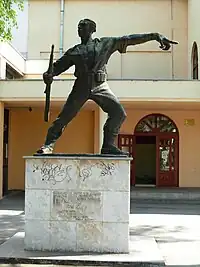
In 1918, Futog, as part of the Banat, Bačka and Baranja region, became part of the Kingdom of Serbia, as was decided by the decree of the Great people's assembly in Novi Sad in 1918, November 2). Since December 1, 1918, it was part of the Kingdom of Serbs, Croats and Slovenes (later known as Yugoslavia). From 1918 to 1922, Futog was part of the Novi Sad County, from 1922 to 1929 a part of the Bačka Oblast, and from 1929 to 1941 a part of the Danube Banovina.
During World War II (in 1941), after the Axis powers invaded and partitioned Yugoslavia, the town came under Axis occupation and was attached to Bács-Bodrog County of Horthy's Hungary. After the defeat of Axis powers there in 1944, one part of the local German population left from the area, together with the defeated German army. The Anti-Fascist Council for the National Liberation of Yugoslavia (AVNOJ) declared the remaining German population as public enemies and sent them to communist prison camps. After the abolishment of the camps in 1948, the remaining German population left from Yugoslavia, mainly because of economical reasons. Since 1944, the town was part of Yugoslav Vojvodina, which from 1945 was a part of socialist Serbia within the new socialist Yugoslavia. After the Second World War, in 1945 and 1946 Futog was settled by Serb families which mostly originated from Bosnia, Lika, and Srem. Population censuses conducted after the war recorded a Serb ethnic majority in the town.
Sights
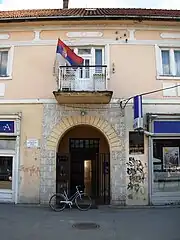
- A baroque Serbian Orthodox Church “Sveti Vrači Kozma i Damjan” from 1776.
- Futog Court, today Agricultural school (baroque-classicism), built by grof Andras Hadik in 1777, where few days before Sarajevo Attempt resided Archduke Franz Ferdinand and his wife Sofia Chotek, and also a place where German general August von Mackensen was prisoned in 1919.
- Old Rectory from 1777 belongs to citizen architecture of the 18th century.
- Serbian Orthodox Church 1781-1947; village baroque.
- “Rudolphinum” or “Bastilja” of 1893; eclecticism; today Internat.
- “Marianum” of 1894; istoricism; today Gerontological centre.
- Roman Catholic Church “Sacred heart of Jesus” of 1908; neogothic cathedral.
- Fire Brigade Home of 1909 with a tower of 1932.
- Roman Catholic Church “Holy Trinity” of 1940, no spiritual practice.
Culture and media
The village is home to the Cultural-Informative Centre “Mladost”, Tambura Orchestra, Folklore Assembly, Town library “Jovan Jovanović Zmaj”, galleries, etc.There is a Radio "Futog" at 97,5 and 99,5 MHz FM and Radio "Srna" at 91,90 MHz FM. The village is also famous for Bojana Kozomora (ex)Kovačević and Zorica Tepić Andrić.
Education
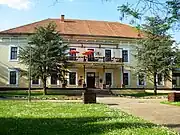
There are two primary schools: “Desanka Maksimović” and “Miroslav Antić”. There is also a secondary Agricultural Boarding School. The first school in the town was established in 1707.
Sport
There is a Sport Hall Futog in the village. Football clubs in the town are OFK “Futog” and FK “Metalac-Asco Vidak”, there is also fight club “Faraon”, volleyball clubs OKK “Futog” and "RFU", handball club RK “Metalac”, and basketball club KK "Futog".
Economy and traffic
Industry includes: “Milan Vidak” wire factory; “Aroma” spice factory; “Garant” motor factory; “Futožanka” provender factory; “Vagar” scale factory; and “Planta” agricultural goods.
Car-road Novi Sad-Bačka Palanka; rail-road Novi Sad-Sombor; and the Danube river are important traffic directions situated at this location.
Novi Sad's regular bus lines 53 (FUTOG STARI), 54 (FUTOG GRMEČKA), 55 (FUTOG BRAĆE BOŠNJAK) and 56 (BEGEČ) connecting the town with Novi Sad.
See also
References
- ↑ "Насеља општине Нови Сад" (PDF). stat.gov.rs (in Serbian). Statistical Office of Serbia. Archived from the original (PDF) on 21 November 2020. Retrieved 23 October 2019.
- ↑ Thomka, Orsolya (2007). Délvidék – A Vajdaság és Belgrád (in Hungarian). Budapest: Ketzal Kft. p. 65. ISBN 978-963-86230-9-6.
- ↑ 2011 Census of Population, Households and Dwellings in the Republic of Serbia: Comparative Overview of the Number of Population in 1948, 1953, 1961, 1971, 1981, 1991, 2002 and 2011, Data by settlements (PDF). Statistical Office of Republic Of Serbia, Belgrade. 2014. ISBN 978-86-6161-109-4. Retrieved 2014-06-27.
- ↑ "Archived copy". Archived from the original on 2011-10-07. Retrieved 2011-06-28.
{{cite web}}: CS1 maint: archived copy as title (link)
Further reading
- Slobodan Ćurčić, Broj stanovnika Vojvodine, Novi Sad, 1996.
 Sports Hall
Sports Hall FK Metalac Stadium
FK Metalac Stadium Train Station
Train Station Market
Market Center of the town
Center of the town Town entry
Town entry Health station
Health station%252C_Serbia.jpg.webp) Danube river near Futog
Danube river near Futog Radio Futog
Radio Futog The Heart of Jesus Catholic (historically German) Church
The Heart of Jesus Catholic (historically German) Church
